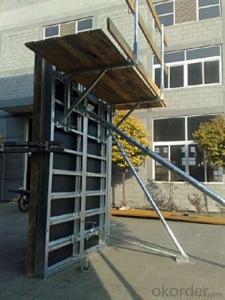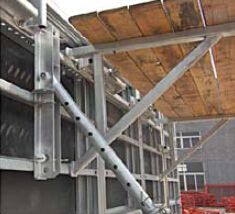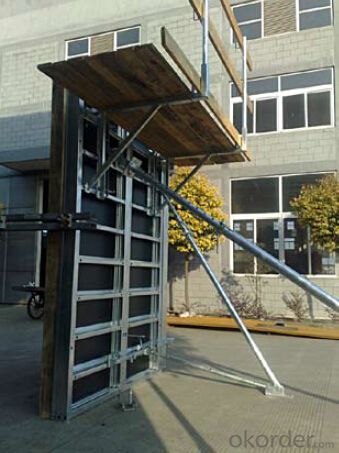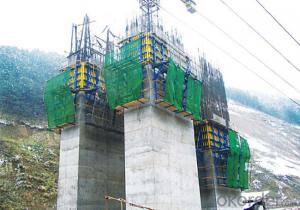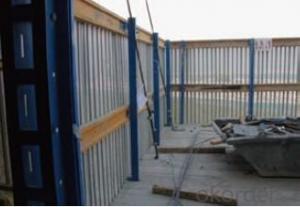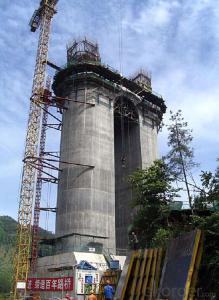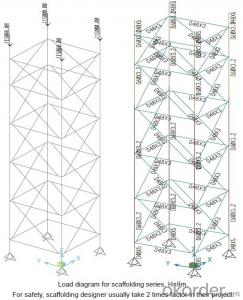Steel-Frame Formwork working platform
- Loading Port:
- China Main Port
- Payment Terms:
- TT OR LC
- Min Order Qty:
- -
- Supply Capability:
- -
OKorder Service Pledge
OKorder Financial Service
You Might Also Like
Steel-frame Formwork SF-140
Characteristics:
◆ Few parts for fast forming.
◆ Max. Concrete pressure: 80KN/m2.
◆ Hot-dip galvanized steel frame.
◆ The thickness of plywood is 18mm & the panel is 14cm.
◆ Compatibility with Hunnebeck Manto system due to similar edge profile.
System Details & Application:
◆ Neat joint and fast assembling with aligning panel clamp.
◆ Flexible panel arrangement and height extension.
◆ The selection of panels.
◆ Kinds of panel connectors.
◆ Corner clamp application.
◆ Length adjustment application.
◆ Height adjustment & aligning strut.
◆ Walkway bracket & platform.
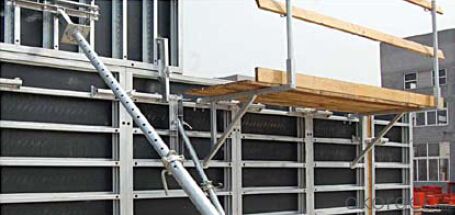
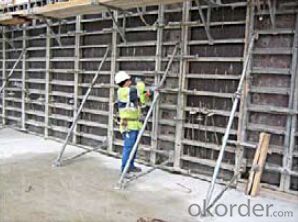
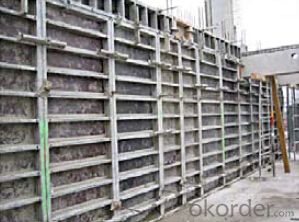
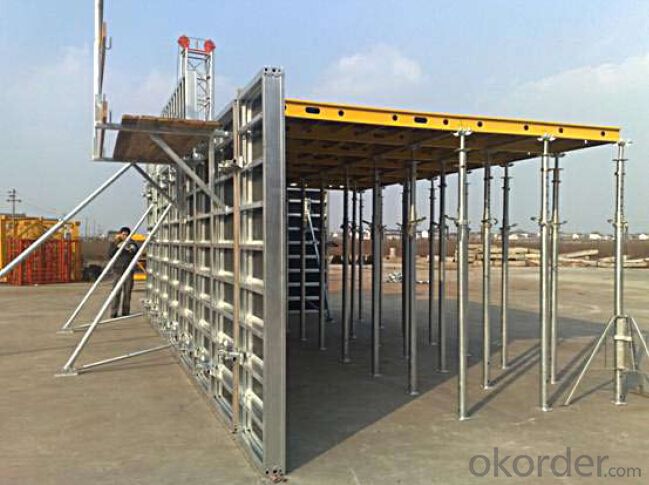
- Q: What are the typical fire resistance ratings of steel formwork systems?
- The typical fire resistance ratings of steel formwork systems can vary depending on various factors such as the specific design, material thickness, and fire protection measures in place. However, steel formwork systems generally have fire resistance ratings ranging from 30 minutes to 120 minutes, providing adequate protection in case of fire incidents.
- Q: Does steel formwork require any special equipment for installation?
- Yes, steel formwork does require special equipment for installation. The installation process involves assembling the steel panels into the desired shape and securing them together. This typically requires the use of specialized tools such as spanners, hammers, or hydraulic jacks to ensure proper alignment and tightness of the formwork. In addition, heavy-duty lifting equipment such as cranes or forklifts may be necessary to move and position the steel formwork panels safely. The use of special equipment ensures that the installation is done accurately and efficiently, resulting in a sturdy and well-constructed formwork system.
- Q: What are the considerations when designing steel formwork for architectural sculptures?
- When designing steel formwork for architectural sculptures, there are several important considerations that need to be taken into account. Firstly, the structural integrity and stability of the formwork is paramount. The formwork must be able to withstand the weight of the concrete or other materials that will be poured into it, as well as any external forces that may be applied during the construction process. This requires careful analysis and engineering to ensure that the formwork is strong enough to support the weight and forces without any risk of collapse. Secondly, the accuracy and precision of the formwork is crucial. Architectural sculptures often require intricate and detailed designs, so the formwork must be able to accurately reproduce these shapes. This may involve using advanced computer-aided design (CAD) software to create precise 3D models of the sculpture, which can then be used to fabricate the formwork. Another consideration is the ease of assembly and disassembly of the formwork. Architectural sculptures can be complex and intricate, so the formwork must be designed in a way that allows for easy assembly and disassembly. This may involve using modular components that can be easily connected and disconnected, as well as incorporating features such as adjustable supports or brackets to accommodate different shapes and sizes. Additionally, the choice of materials for the formwork is important. Steel is a common choice due to its strength and durability, but other materials such as aluminum or fiberglass may also be used depending on the specific requirements of the project. The materials used must be able to withstand the weight and forces applied during construction, as well as any potential exposure to weather or other environmental conditions. Finally, considerations should be made for the aesthetics of the formwork. While the primary function of the formwork is to support the construction process, it is also important that it does not detract from the overall visual impact of the sculpture. This may involve using smooth finishes, hidden connections, or other design techniques to ensure that the formwork remains visually appealing. In conclusion, designing steel formwork for architectural sculptures requires careful consideration of factors such as structural integrity, accuracy, ease of assembly, material selection, and aesthetics. By addressing these considerations, designers can ensure that the formwork is not only functional and safe but also enhances the overall artistic vision of the sculpture.
- Q: Are there any specific considerations for using steel formwork in areas with high wind loads?
- There are various factors to consider when using steel formwork in areas with high wind loads. Firstly, the design of the steel formwork must be strong and capable of withstanding the potential forces exerted by strong winds. This involves ensuring that the formwork is securely anchored to the ground or structure to prevent displacement or collapse. In addition, the formwork must be adequately braced and reinforced to resist the lateral forces generated by high winds. This may require the use of additional cross-bracing, diagonal supports, or stiffeners to enhance the structural integrity of the formwork. The materials used in constructing the steel formwork should also be carefully chosen to withstand the corrosive effects of wind-driven rain, saltwater spray, or other environmental factors present in areas with high wind loads. This may involve using corrosion-resistant steel or applying protective coatings to prevent rust or deterioration. Moreover, the erection and dismantling of the steel formwork should be meticulously planned and executed, considering the potential risks associated with high winds. It is crucial to follow proper safety procedures and guidelines to ensure the stability and integrity of the formwork during installation and removal. Lastly, regular inspections and maintenance of the steel formwork should be carried out to identify and address any potential issues or damage caused by high winds. This may include checking for loose connections, signs of deformation, or any other indications of structural compromise. In conclusion, the use of steel formwork in areas with high wind loads necessitates careful consideration and implementation of specific measures to guarantee the safety and stability of the formwork. By addressing design, reinforcement, material selection, installation, and maintenance, the steel formwork can effectively withstand the challenges posed by high winds.
- Q: How is steel formwork assembled and disassembled?
- Steel formwork is assembled and disassembled in a systematic and sequential manner to ensure efficient construction processes. The assembly process generally begins with the foundation preparation, where the steel formwork components are laid out according to the desired shape and dimensions of the structure. The first step in assembling steel formwork involves connecting the vertical and horizontal components using various connecting devices such as pins, bolts, or clips. These components, which include panels, walers, and soldiers, are interconnected to form a rigid framework that provides the necessary support and shape for the concrete structure. Once the initial framework is assembled, the next step involves the placement of form ties or clamps, which are used to hold the formwork panels firmly in place. These ties or clamps are inserted through holes in the panels and then secured tightly on the opposite side to prevent any movement during the pouring and curing of the concrete. After the concrete is poured and cured, the disassembly process begins. This process is carried out in reverse order, starting with the removal of the form ties or clamps. Once these are removed, the formwork panels can be easily detached from the framework, allowing for the removal of the soldiers and walers. The disassembly of steel formwork also involves carefully dismantling the vertical and horizontal components, ensuring that no damage is caused to the framework or the panels. This is done by removing the connecting devices, such as pins, bolts, or clips, and then systematically disassembling the various components. It is important to note that the assembly and disassembly of steel formwork should be carried out by experienced and trained professionals to ensure safety and avoid any potential accidents or structural failures. Following proper procedures and guidelines is crucial to guarantee the successful completion of a construction project using steel formwork.
- Q: Can steel formwork be used for hospital construction projects?
- Indeed, hospital construction projects can make use of steel formwork. This construction material, known for its versatility and durability, brings forth numerous advantages for such projects. Notably, it offers outstanding strength and stability, crucial factors in ensuring the building's safety and integrity. Moreover, steel formwork enables efficient and precise construction due to its ease of assembly and disassembly. Its modular nature also permits flexibility in design and layout changes. Another noteworthy feature is its smooth surface finish, which plays a vital role in maintaining a hygienic environment within a hospital setting. Furthermore, steel formwork exhibits resistance to moisture and chemicals, making it suitable for areas requiring frequent cleaning and sterilization. Overall, when it comes to hospital construction projects, steel formwork proves itself as a reliable and suitable option.
- Q: Are there any specific considerations for using steel formwork in areas with limited power supply?
- Yes, there are several specific considerations for using steel formwork in areas with limited power supply. Firstly, steel formwork typically requires power tools for assembly and disassembly. In areas with limited power supply, it may be challenging to operate these tools efficiently. Alternative methods such as manual tools or hand-held equipment may need to be used, which can significantly increase the time and labor required for formwork installation and removal. Secondly, steel formwork often requires welding or cutting, which typically relies on electricity. In areas with limited power supply, finding suitable alternatives for these processes becomes crucial. For example, gas-powered welding machines or oxy-fuel cutting equipment may need to be considered. However, these alternatives come with their own set of challenges, such as obtaining and storing fuel safely. Additionally, areas with limited power supply may also face issues related to lighting. Adequate lighting is essential during formwork installation and concrete pouring to ensure accuracy and safety. Using alternative lighting sources such as battery-powered or solar-powered lights may be necessary. Furthermore, steel formwork often requires proper cleaning and maintenance to ensure its longevity and reusability. Cleaning equipment, such as pressure washers or power scrubbers, may not be readily available in areas with limited power supply. In such cases, manual cleaning methods or low-power alternatives may need to be employed. Lastly, power supply limitations may also affect the overall productivity and efficiency of the construction project. With limited power, it may be necessary to carefully plan and schedule the use of power-intensive equipment, such as concrete mixers or pumps, to minimize disruptions and maximize the available power resources. In conclusion, using steel formwork in areas with limited power supply requires careful consideration and planning. Alternative methods, tools, and equipment may need to be employed to overcome the challenges posed by the lack of power availability. It is essential to assess the specific requirements of the project and consult with experts to ensure the successful implementation of steel formwork in such areas.
- Q: How does steel formwork affect the overall construction site productivity?
- The overall productivity of a construction site can be significantly influenced by the use of steel formwork. One of the main advantages of steel formwork is its durability and strength, which allows for multiple reuses on various construction projects. This reusability factor reduces the time and resources needed for formwork installation, thereby increasing the productivity of the construction site. In addition, steel formwork offers better accuracy and precision in shaping concrete structures compared to traditional wooden formwork. The standardized dimensions and design of steel formwork ensure consistent and uniform results, minimizing the need for adjustments or corrections during the construction process. This leads to faster and more efficient construction, saving time and improving productivity. Furthermore, steel formwork is easy to assemble and disassemble, enabling quick and efficient formwork installation and removal. This reduces the idle time of workers and equipment, maximizing resource utilization and increasing productivity on the construction site. Moreover, steel formwork provides excellent strength and stability, allowing for higher concrete pouring rates and reducing the risk of formwork failure. This allows construction teams to work at a faster pace, pouring larger volumes of concrete in a shorter period, ultimately enhancing overall productivity. Lastly, steel formwork is highly resistant to adverse weather conditions and can withstand harsh environments. This durability ensures that construction activities can continue without interruptions caused by bad weather, leading to improved site productivity. In conclusion, the use of steel formwork positively impacts construction site productivity by offering durability, reusability, accuracy, ease of assembly, and resistance to weather conditions. These factors contribute to faster construction, reduced downtime, and optimized resource utilization, ultimately enhancing overall productivity on the construction site.
- Q: What are the main components of steel formwork?
- The steel formwork system consists of panels, stiffeners, and connecting brackets as its main components. The panels, which are constructed from high-quality steel sheets, are known for their rigidity and durability. They are available in various sizes and shapes, including rectangular, square, or circular, depending on the desired shape of the concrete structure. These panels are designed to endure the pressure exerted by the concrete during pouring and curing. To reinforce the steel formwork panels and enhance their load-bearing capacity, stiffeners are employed. These stiffeners are typically welded or bolted onto the panels to provide additional strength and stability. They play a crucial role in projects of larger scale or when dealing with heavy concrete loads. Connecting brackets serve as a vital element in the assembly of the steel formwork system. They are used to connect the formwork panels together, ensuring proper alignment and stability. Made of steel, these brackets securely hold the formwork panels in place. They are simple to install and remove, allowing for efficient and convenient formwork assembly. In summary, steel formwork offers several advantages, such as high strength, durability, and reusability. Its main components, including panels, stiffeners, and connecting brackets, work collaboratively to create a sturdy and dependable system capable of withstanding concrete pouring pressure and delivering a smooth and precise surface finish.
- Q: How does steel formwork compare to plywood formwork?
- Steel formwork and plywood formwork are commonly used materials in construction for creating molds or frameworks for concrete structures. Both materials have their pros and cons, but steel formwork generally has several advantages over plywood formwork. One of the main benefits of steel formwork is its durability and longevity. Steel is a strong material that can handle heavy loads and repeated use without losing its structural integrity. Unlike plywood, which can warp, expand, or deteriorate over time due to moisture, steel formwork can be used for multiple projects, making it a cost-effective choice in the long term. Another advantage of steel formwork is its precision and accuracy. Steel molds can be manufactured with great precision, ensuring that the final concrete structure meets all the required specifications. This is especially important for complex or intricate designs where accuracy is crucial. Plywood formwork may not provide the same level of precision due to its flexibility and susceptibility to warping. Steel formwork also offers improved safety features. Due to its rigidity and strength, steel molds provide a stable and secure working platform for construction workers. This reduces the risk of accidents and injuries during the concrete pouring and curing process. Plywood formwork, although commonly used, may have a higher risk of collapse or failure, especially in large-scale projects or areas with adverse weather conditions. Furthermore, steel formwork can be easily assembled and disassembled, allowing for efficient and quick construction processes. Steel molds are usually prefabricated and can be easily transported to the construction site, minimizing the need for on-site carpentry work. Plywood formwork, on the other hand, requires more time and effort to set up and dismantle, resulting in longer construction timelines and increased labor costs. However, it is important to note that steel formwork is generally more expensive upfront compared to plywood formwork. The initial cost of steel molds may be higher, but their long-term value and durability make them a worthwhile investment, especially for large construction projects or projects that require repetitive use of formwork. In conclusion, while both steel formwork and plywood formwork have their advantages, steel formwork offers several benefits in terms of durability, precision, safety, and efficiency. Despite the higher initial cost, steel formwork is a reliable and cost-effective choice for construction projects, particularly those that require high-quality finishes and complex designs.
Send your message to us
Steel-Frame Formwork working platform
- Loading Port:
- China Main Port
- Payment Terms:
- TT OR LC
- Min Order Qty:
- -
- Supply Capability:
- -
OKorder Service Pledge
OKorder Financial Service
Similar products
Hot products
Hot Searches
Related keywords

